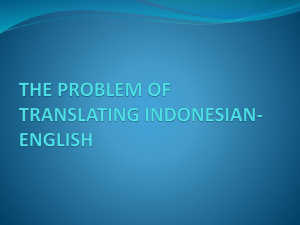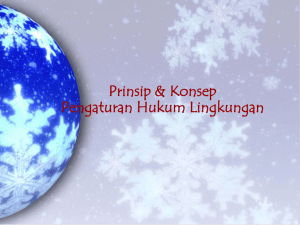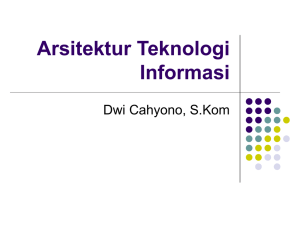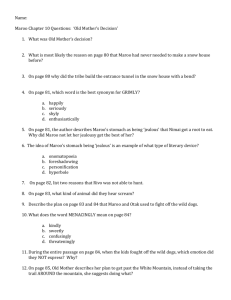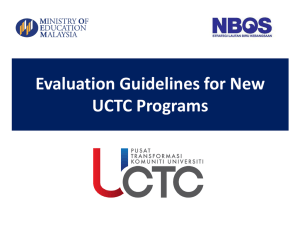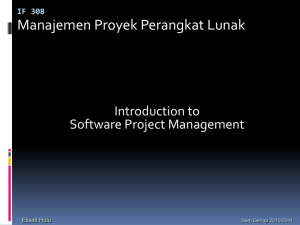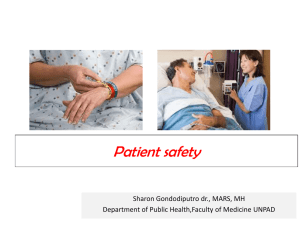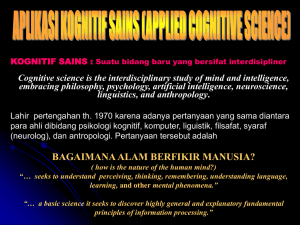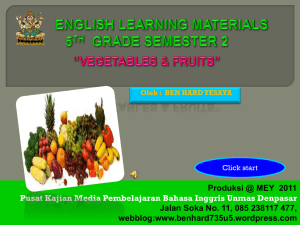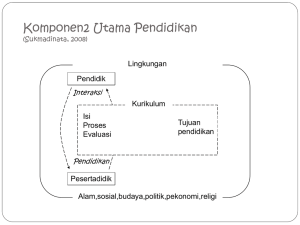CREATIVE THINKING
advertisement
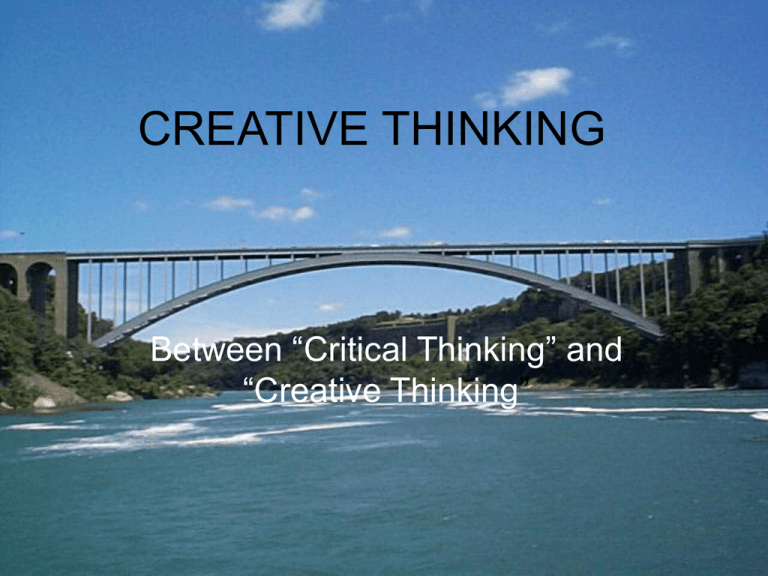
CREATIVE THINKING Between “Critical Thinking” and “Creative Thinking” Thinking out of the box EXERCISE GUNAKAN JALUR KANAN UNTUK MENDAHULUI Penerbangan Gila! CRITICAL THINKING Reasoning Problem Solving Decision Making Formal / Informal Baik / Buruk Definisi Ketidakpastian Soliditas Solusi Strategis Strategi Kreatif Probabilitas Heuristik OTAK KIRI DAN KANAN OTAK KIRI / LEFT OTAK KANAN / RIGHT Analitis, kalkulasi, perincian Intuitif, kreatif, ekstensif Linear dan konvergen Lateral dan Divergen Konvensional Kontroversial Normal ( waras) Abnormal (gila) To bad can be good Andy Groove “Only paranoid can survive.” No Dare to Fail Dare to fail! Good Great Satisfy Kaizen (continuous improvement) Left Brain & Right Brain FACTS VERBAL IDEAS SPATIAL STRUCTURED OPEN-ENDED SEQUENCE RELATIONSHIPS OUTLINE INTUITIVE LOGICAL SUMMARY Human Information Processing -- HIPS PERBEDAAN ANTARA OTAK KIRI DAN OTAK KANAN OTAK KIRI OTAK KANAN OTAK KIRI OTAK KANAN 1. 2. 3. 4. 5. 6. 7. 8. 9. 10. 11. 12. 13. 14. 15. 16. 1. 2. 3. 4. 5. 6. 7. 8. 9. 10. 11. 12. 13. 14. 15. 16. 1. 2. 1. 2. INTELEKTUAL LOGIS KATA DEDUKTIF TETAP STATIS HAPALAN FAKTA SEMPIT DANGKAL PASIF JAWABAN REAKTIF SERIUS BIMBINGAN KETAKUTAN EMOSIONAL INTUITIF GAMBAR INDUKTIF SEMENTARA DINAMIS PEMAHAMAN GAGASAN LUAS DALAM AKTIF PERTANYAAN AKTIF PENASARAN INISATIF KEPERCAYAAN 3. 4. 5. 6. 7. 8. 9. 10. 11. 12. 13. 14. PEKERJAAN JANGKA PENDEK KAKU PERATURAN TESIS TERTUTUP STABILITAS AKAL SEHAT RAMALAN KAKU TAKTIK BENTUK DOGMA MANAGER 3. 4. 5. 6. 7. 8. 9. 10. 11. 12. 13. 14. KEHIDUPAN JANGKA PANJANG FLEKSIBEL RISIKO SINTESIS TERBUKA PERUBAHAN IMAJINASI EKSPLORASI SPONTAN STRATEGI ISI PENEMUAN LEADER What is creative thinking or creative problem solving? • The creative person uses information to form new ideas. • The real key to creative problem solving is what you do with the knowledge. • Creative problem solving requires an attitude that allows you to search for new ideas and use your knowledge and experience. • Change perspective and use knowledge to make the ordinary extraordinary and the usual commonplace. DEFINITION • • Creative problem solving is - DEFINITION “Creative problem solving is - looking at the same thing as everyone else and thinking something different.” Adapted from a famous quote from a former Nobel prize winner, Albert Szent-Gyorgi. LET’S TALK ABOUT: • Why don’t we think creatively more often? • What are the barriers that get in our way? GUILFORD JP (March 7, 1897 – November 26, 1987 • • 1) 2) 3) 4) Membuat studi psikometrik tentang intelektualitas dan kreativitas Ia menekankan pemikiran DIVERGEN: fluency (the ability to produce great number of ideas or problem solutions in a short period of time); flexibility (the ability to simultaneously propose a variety of approaches to a specific problem); originality (the ability to produce new, original ideas); elaboration (the ability to systematize and organize the details of an idea in a head and carry it out). “ Untuk menghadapi dunia dewasa ini, kita lebih membutuhkan seorang yang kreatif daripada seorang pintar” (Guilford) PENSAMIENTO LINEAL PEMIKIRAN LATERAL KONVERGEN DIVERGEN PEMIKIRAN LINEAL PEMIKIRAN LATERAL Bergerak bila ada satu petunjuk / arah Bergerak untuk menciptakan banyak arah Bertolak dari sekuens (urutan) ide-ide Bisa ada lompatan Setiap langkah harus benar dan tepat Tidak secara tepat Menggunakan negasi untuk memblokade hal lain Tidak menolak jalan apa pun PEMIKIRAN LINEAL PEMIKIRAN LATERAL Yang tidak ada kaitannya dengan tema dibuang Diperhatikan semua termasuk hal yang tidak berkaitan dengan tema Kategori, klaisifikasi, etiket adalah wajib Tidak demikian Mengikuti jalan yang jelas Mengikuti jalan yang kurang jelas Sebuah proses yang berakhir Proses tanpa akhir Ciri orang Kreatif • • • • Rasa ingin tahu Mengambil risiko. Kompleksitas atau suka akan kesulitan. Imajinasi: penggunaan semua indra untuk menghasilkan ide, gambaran, penyelesaian yang tidak biasa soluciones Sumber Kreativitas • • • • • • • Ketidaktahuan Pengalaman Motivasi Penilaian yang tepat Style (cara) Kecelakaan, kesalahan, kegilaan. Pembebasan Kreativitas membutuhkan • Kelancaran menghasilkan ide • Originalitas: ide baru dan berbeda • Fleksibel: Bisa dikombinasi bila tidak berfungsi • Elaborasi: mengorganisir, mengelaborasi, dan memperkaya CREATIVE PROBLEM SOLVING PROCESS STEP 1. State what appears to be the problem. The real problem may not surface until facts have been gathered and analyzed. Therefore, start with what you assume to be the problem, that can later be confirmed or corrected. CREATIVE PROBLEM SOLVING PROCESS STEP 2. Gather facts, feelings and opinions. • What happened? • Where, when and how did it occur? • What is it’s size, scope, and severity? • Who and what is affected? • Likely to happen again? • Need to be corrected? • May need to assign priorities to critical elements. CREATIVE PROBLEM SOLVING PROCESS STEP 3. Restate the problem. The real facts help make this possible, and provide supporting data. The actual problem may, or may not be the same as stated in Step 1. CREATIVE PROBLEM SOLVING PROCESS STEP 4. Identify alternative solutions. Generate ideas. Do not eliminate any possible solutions until several have been discussed. CREATIVE PROBLEM SOLVING PROCESS STEP 5. Evaluate alternatives. • Which will provide the optimum solution? • What are the risks? • Are costs in keeping with the benefits? • Will the solution create new problems? CREATIVE PROBLEM SOLVING PROCESS STEP 6. Implement the decision! • Who must be involved? • To what extent? • How, when and where? • Who will the decision impact? • What might go wrong? • How will the results be reported and verified? CREATIVE PROBLEM SOLVING PROCESS STEP 7. Evaluate the results. • Test the solution against the desired results. • Make revisions if necessary. 10 Questions To Encourage Ideas 1. What if…? 2. How can we improve…? 3. How will the Optimist Member and/or the community benefit? 4. Are we forgetting anything? 5. What’s the next step? 10 Questions To Encourage Ideas 1. 2. 3. 4. 5. What can we do better…? What do you think about…? What should we add? What should we eliminate? What other ideas do you have...? BARRIERS THAT GET IN OUR WAY • • • • • • Time Why change? Usually don’t need to be creative Habit Routine Haven’t been taught to be creative What are some other barriers that get in our way?

